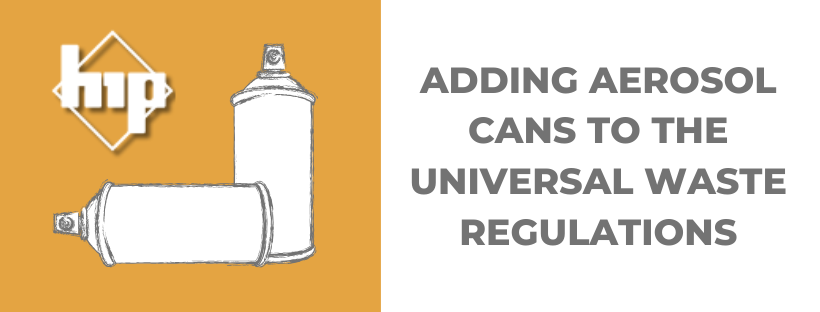December 9, 2019
EPA FINAL RULE
EPA UNIVERSAL WASTE AEROSOL CANS
Adding Aerosol Cans to the Universal Waste Regulations
“The Environmental Protection Agency is adding hazardous waste aerosol cans to the universal waste program under the Federal Resource Conservation and Recovery Act (RCRA) regulations. This change will benefit the wide variety of establishments generating and managing hazardous waste aerosol cans, including the retail sector, by providing a clear, protective system for managing discarded aerosol cans”.
“Aerosol cans are widely used for dispensing a broad range of products including paints, solvents, pesticides, food and personal care products, and many others. The Household & Commercial Products Association (HCPA) estimates that 3.75 billion aerosol cans were filled in the United States in 2016 for use by commercial and industrial facilities as well as by households. Aerosol cans can account for nearly 40 percent of retail items that are managed as hazardous waste at large retail facilities”.
With this rule, EPA adds hazardous waste aerosol cans to those “universal wastes” regulated under title 40 of the Code of Federal Regulations (CFR), part 273. This change in the Resource Conservation and Recovery Act (RCRA) regulations is expected to reduce regulatory costs for a wide variety of establishments generating and managing aerosol cans, including the retail sector, by providing a clear, protective system for handling hazardous waste aerosol cans”.
STATE PROGRAMS
“The aerosol can universal waste programs in California, Colorado, New Mexico, Ohio, and Utah allow for puncturing and draining of aerosol cans by universal waste handlers, as long as specific management standards and waste characterization requirements are met”.... “EPA used these state programs as models for this rule”.
RULE HISTORY
“The federal Universal Waste program, established in 1995, creates a streamlined mechanism for collection and recycling of Resource Conservation and Recovery Act (RCRA) hazardous waste. From 1995 to 2018, four waste streams had been added to the federal Universal Waste program”.
“EPA is adding aerosol cans to the list of universal wastes because this waste meets the factors found at 40 CFR 273.81 that describe hazardous waste appropriate for management under the streamlined universal waste system. Adding aerosol cans to the Universal Waste Rule simplifies handling and disposal of the wastes for generators, while ensuring that universal waste aerosol cans are sent to the appropriate destination facilities, where they will be managed as a hazardous waste with all applicable Subtitle C requirements to ensure protection of human health and the environment. Management as universal waste under the final requirements is also expected to facilitate environmentally sound recycling of the metal used to make the cans”.
“The streamlined universal waste regulations are expected to:
Ease regulatory burdens on retail stores and others that discard aerosol cans,
Promote the collection and recycling of aerosol cans, and
Encourage the development of municipal and commercial programs to reduce the quantity of these wastes going to municipal solid waste landfills or combustors”.
AEROSOL CAN
“EPA is finalizing a definition of “aerosol can” that is consistent with language in the DOT regulations. In the final rule, aerosol can is defined as a non-refillable receptacle containing a gas compressed, liquefied or dissolved under pressure, the sole purpose of which is to expel a liquid, paste, or powder and fitted with a self-closing release device allowing the contents to be ejected by the gas. Using language from the DOT regulation will help ensure consistency across Federal regulatory programs, avoid unnecessarily narrowing the scope of the rule to aerosol cans that aerate their product, and will not inadvertently include compressed gas cylinders in the definition of aerosol can”.
HAZARD WASTE
“Aerosol cans frequently contain flammable propellants such as propane or butane which can cause the aerosol can to demonstrate the hazardous characteristic for ignitability (40 CFR 261.21).[3] In addition, the aerosol can may also be a hazardous waste for other reasons when discarded. More specifically, an aerosol can may contain materials that exhibit hazardous characteristics per 40 CFR part 261, subpart C. Similarly, a discarded aerosol can may also be a P- or U- listed hazardous waste if it contains a commercial chemical product found at 40 CFR 261.33(e) or (f)”.
CYLINDERS
“Because compressed gas cylinders, unlike aerosol cans, require special procedures to safely depressurize, it would not be appropriate to include them in the final rule. Finally, because the DOT language is more inclusive than the proposed language, it better matches the intent of the proposal to apply to all types of aerosol cans, including cans that dispense product in the form of paste or powder, and would not require states that have already added aerosol cans to their universal waste program to change their regulations”.
NON-ACUTE EMPTY
“Under 40 CFR 261.7(b),[19] a container that has held non-acute hazardous waste is “empty” if (1) all wastes have been removed that can be removed using the practices commonly employed to remove materials from that type of container, e.g., pouring, pumping, and aspirating (applicable in all cases), and (2) no more than 2.5 centimeters (one inch) of residue remains on the bottom of the container or inner liner, or (3) no more than 3 percent by weight of the total capacity of the container remains in the container or inner liner if the container is less than or equal to 119 gallons in size. In addition, a container that has held a hazardous waste that is a compressed gas is empty when the pressure in the container approaches atmospheric pressure”.
ACUTE EMPTY
“In the case of a container that has held an acute hazardous waste listed in 40 CFR 261.31 or 261.33(e), the container is considered empty when it has been triple rinsed or has been cleaned by another method that has been shown in scientific literature, or by tests conducted by the generator to achieve equivalent removal, per 40 CFR 261.7(b)(3)”.
“EPA also considers a container that has held an acute hazardous that is a compressed gas to meet the definition of empty when it approaches atmospheric pressure, as defined in 40 CFR 261.7(b)(2).[20] EPA is not aware of a chemical commonly found in aerosol cans that would be listed as an acute hazardous waste, but if such an aerosol can product does exist, it would have to meet the 40 CFR 261.7(b)(2) or (3) standard to be considered “empty” under the regulations”.
RECYCLING AEROSOL CANS
“However, in the case of aerosol cans being recycled, rather than disposed of, aerosol cans that have been punctured and drained prior to recycling are considered exempt scrap metal under 40 CFR 261.6(a)(3)(ii), and therefore all such punctured cans would be exempt from hazardous waste requirements when recycled”.
(NOTE), “California does not allow off-site commercial processors to puncture and drain aerosol cans without a permit and requires those handlers that do puncture and drain cans to submit a notification and guidance in effect in Minnesota at the time of publication of the final rule also allows handlers to puncture and drain their aerosol cans”.







